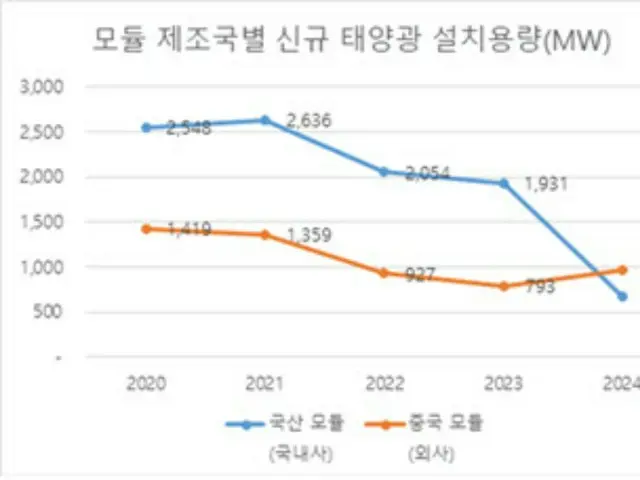According to documents submitted by the Ministry of Trade, Industry and Energy to Park Ji-hye, a member of the National Assembly's Committee on Small and Medium Enterprises and Startups, the number of solar power generation plants in South Korea is
The number of equipment manufacturers was found to have halved in five years, from 46 in 2017 to 23 in 2022.
The number of module companies has dropped significantly from 33 to 20, while the number of ingot companies has increased.
The lifeline for material manufacturers such as semiconductor manufacturers and wafer manufacturers has been completely cut off. Export performance is also not as good as it once was. Exports, which once reached 3.47 trillion won (approximately 383.8 billion yen) in 2017, have fallen to just 1.5 trillion won in 2018.
It is expected to fall to 1.3026 trillion won (about 144 billion yen) in 2021, and remain at 2.3802 trillion won (about 262 billion yen) in 2022, remaining at two-thirds of the level five years ago.
This is believed to be the result of the low-price offensive of Chinese products. According to documents from the Ministry of Trade, Industry and Energy, the use of Chinese-made modules in new solar power generation facilities in Korea is
The amount of solar power generation equipment made in Korea has not spread as quickly as it used to. The solar power generation capacity in Korea has declined from 0.7 gigawatts in 2012 to 2.
In 2017, it increased more than seven-fold to 5.1 gigawatts, but the rate of increase between 2017 and 2022 is expected to be only about four-fold. Although the power supply itself has increased significantly, its growth potential is declining.
The Korean government's energy policy also focuses on nuclear power and wind power, rather than solar power, which is difficult to control due to its intermittency.
The Jeju and Honam regions, which are located in the southern part of the country, are facing concerns about power outages due to an oversupply of electricity during daytime hours when solar power generation is at its highest, and there is also a lack of expansion of the power grid to accommodate power transfer between regions.
At the National Assembly's audit of the Ministry of Trade, Industry and Energy on the 7th, Rep. Park Ji-hye also asked Minister of Trade, Industry and Energy Ahn Deok-keun to take measures to prevent the spread of industrial complexes and other industrial projects.
The ministry has called for the government to further flesh out the plan to promote the use of solar power generation facilities. The Ministry of Trade, Industry and Energy announced a plan to promote solar power generation in industrial complexes in July this year, and currently has 2.1 gigawatts of solar power generation facilities.
The government has set a plan to increase the number of solar panels by 2030, but has no annual plan for their dissemination. Of this, the government's support budget for new and renewable energy financial support projects is set to 572.1 billion won (about 63.3 billion yen) in 2022.
The current budget has been nearly halved from the current level (US$300 million) to 326.3 billion won (US$360 million) in 2025 (based on the government budget proposal).
Rep. Park said, "In 2018, the Ministry of Trade, Industry and Energy announced a target of increasing solar power generation capacity in industrial complexes to 3.2 gigawatts by 2022.
"However, as of June this year, it is only 2.1 gigawatts," he said, adding, "We need to specify targets for each fiscal year and increase support policies."
"We need to consider introducing stable and consistent policies for the promotion of renewable energy, including through legislation to set targets for its adoption, while also fostering a supply chain for the domestic solar power industry," he added.
2024/10/09 07:07 KST
Copyrights(C) Edaily wowkorea.jp 107

